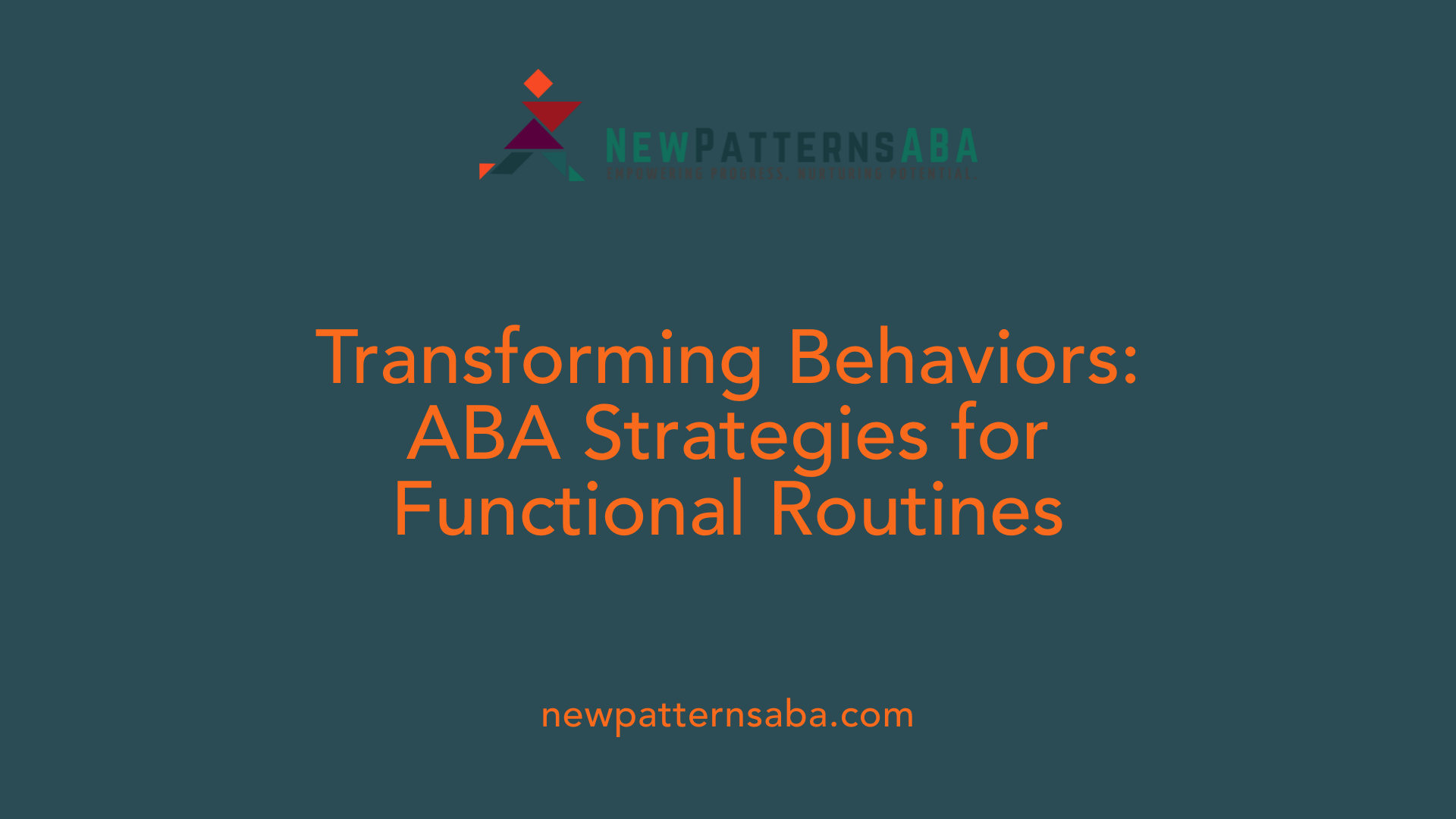Enhancing Child Development Through Structured Daily Activities
Applied Behavior Analysis (ABA) has emerged as a cornerstone in supporting children, especially those on the autism spectrum, to develop meaningful daily routines. By integrating evidence-based strategies into everyday activities, ABA helps foster independence, improve communication, and promote social skills. This article explores how ABA therapy can be seamlessly woven into daily life, the techniques employed, and the benefits for children's overall development.
Integrating ABA into Daily Routines for Children
Transforming everyday activities into valuable learning opportunities is a fundamental aspect of ABA therapy. By embedding skill-building tasks within routine activities like mealtimes, chores, play, and outings, children can develop communication, social, and problem-solving skills naturally.
For example, during meal preparation, parents can encourage children to request items using appropriate language, turning a simple act into a teaching moment. Similarly, during play, turning tasks into structured activities with clear steps helps children practice and master skills such as sharing or following instructions.
Visual schedules and visual aids play a vital role in fostering predictability and understanding. Using pictures or timers helps children anticipate what comes next, reducing anxiety and aiding transitions throughout the day. These visual tools make the routines more concrete, especially for children on the autism spectrum who thrive on repetition and predictability.
Incorporating positive reinforcement and offering choices during daily routines further promotes engagement and independence. Praising children immediately after desired behaviors, providing small rewards like stickers or verbal praise, and allowing choices—such as selecting a shirt or game—encourages motivation and cooperation.
Routine interactions are also opportunities to build communication skills and foster autonomy. For instance, encouraging a child to request help or items using appropriate words or signs during chores and play helps develop language abilities. Simplifying tasks into smaller steps through task analysis makes complex activities manageable, such as guiding a child through brushing teeth step-by-step.
Parental involvement is essential for success. Collaborating with an ABA therapist ensures strategies are tailored to the child's needs and goals. Teachers and caregivers can support consistency by reviewing routines, staying flexible when needed, and modeling desired behaviors.
Ultimately, integrating ABA strategies into daily routines establishes a stable, predictable environment that supports ongoing development. It helps children learn in natural contexts, making skills meaningful and more likely to generalize across settings. Patience, encouragement, and regular reinforcement lay the groundwork for lasting progress in communication, independence, and social interaction.
| Strategy | Practical Application | Benefits | Additional Tips |
|---|---|---|---|
| Visual schedules | Use pictures or timers to plan daily activities | Reduces anxiety, clarifies expectations | Review schedules regularly and involve the child in planning |
| Positive reinforcement | Offer praise, stickers, or small rewards immediately after desired behaviors | Encourages repetition and motivation | Tailor rewards to the child's preferences |
| Offering choices | Let children choose between options during routines | Promotes independence and decision-making | Keep options simple and relevant |
| Breaking down tasks | Chunk complex activities into manageable steps | Builds skills step-by-step | Use visual aids to demonstrate steps |
| Consistency and flexibility | Maintain routines but adapt as needed | Supports learning and emotional security | Incorporate family input and monitor progress |
Applying ABA techniques within daily routines transforms ordinary moments into effective teaching opportunities. This natural approach promotes positive behaviors, enhances communication, and nurtures independence, supporting children in reaching their full potential.
Techniques Used in ABA to Support Routines

What techniques are used in ABA therapy to develop and support children's routines?
ABA therapy employs a range of methods to help children develop consistent and functional routines, which are especially important for children on the autism spectrum. One foundational technique is task analysis—a process that breaks down complex activities into smaller, manageable steps. For example, learning to brush teeth can be split into steps like picking up the toothbrush, applying toothpaste, and brushing for a set amount of time. This step-by-step approach makes it easier for children to grasp each component and perform the entire task independently.
Visual cues also play a vital role. Visual schedules, timers, and other visual aids help increase predictability and understanding of daily routines. For instance, a visual timetable outlining the sequence of activities during the day helps children know what to expect, reducing anxiety and enhancing their ability to transition smoothly between tasks.
Prompting, prompting fading, and shaping are additional techniques used to establish routines. Prompts—such as gestures, hints, or verbal cues—guide children toward desired behaviors. Over time, prompts are gradually faded, encouraging children to perform routines independently. Shaping reinforces successive approximations toward the target behavior, gradually building complex skills by rewarding small successes.
Embedding these techniques into natural settings further enhances their effectiveness. Incorporating routines into everyday activities like mealtimes, chores, or playtime transforms learning into meaningful experiences. When children practice routines in familiar environments, they can generalize skills across settings, which supports long-term independence.
Collaboration with parents and therapists ensures that routines are tailored to each child's unique needs and preferences. Consistency across home, school, and therapy settings helps establish stable routines and promotes ongoing development.
In summary, ABA combines task analysis, visual supports, prompting, and reinforcement strategies into daily routines. This integrated approach fosters skill acquisition, increases independence, and helps children navigate their environment with confidence, creating a foundation for lifelong learning and adaptive behaviors.
Goals of ABA in Establishing and Supporting Routines

What are the goals of ABA therapy in establishing and supporting children's daily routines?
ABA therapy aims to create a structured environment that fosters skill development and behavioral improvements in children, particularly those with autism. One primary goal is promoting independence. This involves teaching children how to carry out daily activities such as toileting, dressing, and feeding through techniques like task analysis and positive reinforcement. By breaking down complex tasks into manageable steps, children learn to perform these activities confidently on their own.
Another key objective is reducing maladaptive behaviors and anxiety. Consistent routines and structured interactions help children feel secure and reduce uncertainty. Visual schedules and timers provide predictability, which can lessen stress during transitions and unfamiliar situations. This sense of stability encourages children to manage changes more smoothly and with less distress.
In addition, ABA therapy focuses on developing functional communication and social skills. Techniques like social stories and role-playing systematically teach children to request objects, express needs, and engage with others effectively. These skills are crucial for building relationships and participating meaningfully in community and school settings.
Ensuring that learned skills are not limited to one environment is also a priority. ABA promotes the generalization of skills across different settings by teaching them in diverse contexts and using reinforcement consistently. This approach helps children transfer what they learn during therapy to everyday life, at home, in the community, or school.
Establishing routines involves collaborative planning with caregivers, who are trained to implement visual schedules, reinforce positive behaviors, and adapt routines to fit each child's unique needs. Over time, prompts are gradually faded to encourage independent performance, leading to lasting improvements.
Ultimately, these routines support children’s confidence, well-being, and autonomy. By systematically combining skill-building with behavioral management, ABA helps children develop lifelong capabilities that promote their full participation in daily life and boost their quality of life.
Benefits of ABA in Developing and Reinforcing Routines

What are the benefits of incorporating ABA therapy into children's daily routines?
Integrating Applied Behavior Analysis (ABA) therapy into daily routines offers a wide range of advantages that support a child's growth and independence. One of the most notable benefits is the improvement in communication and social skills. By embedding learning opportunities within familiar activities such as mealtimes, chores, or play, children learn to express themselves, request needs appropriately, and interact socially, which enhances their overall social development.
ABA strategies also promote emotional regulation and reduce stress. Consistent routines, reinforced by visual schedules and timers, help children understand what to expect each day, creating a sense of predictability and safety. This structure decreases anxiety during transitions and fosters calmness, making it easier for children to manage their emotions.
Furthermore, ABA encourages independence and boosts confidence. Through step-by-step task analysis, children learn essential skills like brushing teeth or choosing clothes, empowering them to perform tasks independently. Positive reinforcement motivates children to try new activities, increasing their internal motivation and curiosity.
Skills learned in structured routines are also more likely to generalize across different environments such as school, home, and community settings. This means that children can apply their new skills in various contexts, leading to lasting improvements. Tailored interventions and continuous parent involvement, including training and collaboration with therapists, reinforce consistency and maximize progress.
In summary, ABA's personalized, evidence-based methods enhance children’s communication, emotional wellbeing, independence, and skill application, helping them thrive in everyday life and build a foundation for lifelong success.
Routines and Child Development: A Vital Connection
Why are routines important in children's development, and how does ABA support this?
Routines play a fundamental role in a child's growth by offering stability and predictability. They help children feel safe and secure, reducing feelings of anxiety that can hinder learning and emotional regulation. Regular routines foster cognitive development by providing consistent opportunities for children to learn new skills, problem-solve, and understand social norms.
For children on the autism spectrum, routines are especially beneficial. They assist in managing sensory sensitivities and help children navigate daily activities with confidence. Routines teach expectations, promote self-regulation, and improve behavior by creating a structured environment that minimizes confusion and sensory overload.
Applied Behavior Analysis (ABA) supports the establishment and reinforcement of routines by breaking down complex activities into manageable steps. Therapists and caregivers use structured instructions and positive reinforcement to encourage compliance and learning. This systematic approach helps children grasp what is expected, build independence, and develop essential social and communication skills.
Incorporating play and functional activities into daily routines makes learning engaging and motivating. For example, turning chores or mealtime into fun, interactive sessions can improve cooperation and social interaction. Consistent routines also aid in developing resilience and executive functioning—skills like planning, flexible thinking, and problem-solving—crucial for long-term success.
By involving families and caregivers, ABA ensures routines are maintained across home and community settings. Visual schedules, timers, and other visual aids make expectations clearer and help children transition smoothly between activities. This comprehensive approach enhances emotional security, promotes motivation, and lays a strong foundation for lifelong learning and adaptation.
Enhancing Behavioral Skills Through ABA in Routines

How does ABA therapy improve behavioral skills related to daily routines?
ABA therapy plays a vital role in strengthening behavioral skills that are essential for managing daily routines. One of its primary methods involves breaking down complex activities into smaller, manageable steps through a process called task analysis. For example, brushing teeth or getting dressed can be taught step-by-step, making these activities less overwhelming for children.
Visual aids and cues are also heavily utilized in ABA to enhance understanding. Visual schedules, timers, and picture prompts help children anticipate what will happen next, reducing uncertainty and stress. These tools serve as consistent reminders and support transitions from one activity to another.
Reinforcing positive behaviors is central to ABA and encourages independence. When children successfully complete a task or follow a routine, immediate praise or rewards boost their motivation and confidence. This reinforcement helps establish a habit of desirable behaviors, such as using utensils during mealtime or following a bedtime routine.
Furthermore, ABA interventions target sensory sensitivities and transitions, which are common challenges for children on the spectrum. Tailored strategies, including sensory breaks and gradual exposure to new routines, improve resilience and flexibility. For instance, slowly introducing new clothes or adjusting bedtime gradually can help reduce resistance or anxiety.
Incorporating routines into natural environments, like home or community settings, ensures that these skills are not only learned but also generalized outside therapy sessions. Children begin to apply routines in real-life situations, leading to greater functional independence.
Overall, ABA promotes the development of routines through consistent, structured, and visually supported activities that foster confidence, enhance self-regulation, and build essential daily living skills. These techniques make routines more predictable and manageable, equipping children to navigate their daily lives more effectively.
Empowering Parents and Caregivers Through ABA Education

What educational information can be provided to parents and caregivers about the impact of ABA therapy on routines?
Parents and caregivers play a vital role in supporting a child's development through ABA therapy by understanding how routines influence learning and behavior. Education on this topic highlights that ABA fosters the development of essential daily skills such as hygiene, meal times, and toileting, ultimately promoting greater independence for the child.
Through targeted parent training, families learn to implement evidence-based techniques like visual schedules, which provide clear visual cues of daily activities, and task analysis, which breaks down complex skills into manageable steps. Positive reinforcement, offered immediately after desired behaviors, encourages their recurrence and helps establish consistent routines.
Incorporating ABA principles into everyday activities—like cooking, chores, play, and outings—turns routine moments into opportunities for learning. For instance, encouraging a child to request items using appropriate language during mealtime can enhance communication skills.
Ongoing collaboration between parents and ABA professionals ensures that routines are tailored to each child's unique needs. Regular guidance and monitoring help reinforce progress, making routines a natural part of daily life.
By understanding that ABA routines are adaptable and focused on practical, real-life situations, caregivers can foster a supportive environment that promotes positive behaviors, reduces challenging behaviors, and strengthens family relationships.
Overall, effective parent involvement and education empower families to sustain progress beyond therapy sessions, integrating skills seamlessly into daily life and enhancing the child's overall development.
Fostering Growth and Independence Through Routine-Based ABA
ABA therapy plays a pivotal role in developing and reinforcing daily routines that are fundamental to a child's growth, independence, and well-being. By integrating evidence-based techniques like visual schedules, positive reinforcement, and task analysis into everyday activities, children learn essential skills such as communication, social interaction, and self-care. These routines provide the stability and predictability necessary for children, particularly those on the autism spectrum, to navigate their environment with confidence. Collaboration with parents and caregivers through education and consistent implementation enhances the child's ability to generalize skills across settings, leading to lasting developmental progress. Embracing routine-based ABA strategies is thus essential in empowering children to lead more autonomous, fulfilling lives.
References
- Integrating ABA Techniques into Everyday Routines
- 7 Key Benefits of ABA Therapy for Children
- Incorporating ABA Therapy into Daily Family Routines
- How ABA Therapy Can Help Children with Autism Thrive
- Importance of Routines - PediaPlex
- ABA Therapy Goals: 25 Practical Examples & Timelines
- How ABA Therapy Builds Consistency for Lasting Success
- Autism Routines: Build a Structured Daily Schedule for Success
- How ABA Therapy Helps Children with Autism Build Routine ...
- Integrating ABA Techniques into Daily Routines: A Guide for Parents





